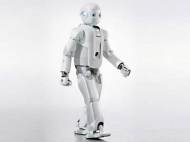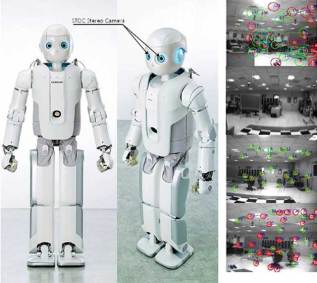Samsung Roboray gets a 3D localization and mapping algorithm
 Researchers at the University of Bristol developed computer vision algorithms that enable creation of real-time 3D visual maps which enable Samsung‘s humanoid robot named Roboray to move around more efficiently. Rapid 3D visual mapping is essential for faster operation of humanoid robots because it provides them with ability to robustly track and recover from rapid motions and occlusions.
Researchers at the University of Bristol developed computer vision algorithms that enable creation of real-time 3D visual maps which enable Samsung‘s humanoid robot named Roboray to move around more efficiently. Rapid 3D visual mapping is essential for faster operation of humanoid robots because it provides them with ability to robustly track and recover from rapid motions and occlusions.
Roboray features a range of novel technologies, and it is among most advanced humanoid robots in the world. It is 140cm (4 ‘ 7″) tall and it weights 50 kg (110 pounds). It has a stereo camera on its head and 53 different actuators including six for each leg and 12 for each hand. By using cameras, the robot builds a map reference relative to its surroundings and is able to “remember” where it has been before.
“A humanoid robot has an ideal shape to use the same tools and spaces designed for people, as well as a good test bed to develop machine intelligence designed for human interaction”, said Dr Walterio Mayol-Cuevas, Deputy Director of the Bristol Robotics Lab who led the research team. “Robots that close the gap with human behaviors, such as by featuring dynamic walking, will not only allow more energy efficiency but be better accepted by people as they move in a more natural manner.”
One of the human-like abilities Roboray has is the way it walks, because it employs dynamic walking. This means that the robot is falling at every step, using gravity to carry it forward without using too much energy. This is the way humans walk and is in contrast to most other humanoid robots that bend their knees to keep the centre of mass low and stable.
Aside being more challenging to achieve, this approach complicates the computer vision algorithms since as objects in images aren’t stabilized and move more quickly. The Bristol team was in charge of the computer vision aspects of 3D simultaneous localization and mapping (SLAM).
“Bristol’s visual SLAM and their other real-time visual technologies have been very beneficial for Samsung Electronics’ humanoid robot project”, said Dr Sukjune Yoon, Samsung Advanced Institute of Technology (SAIT). “Mapping in real-time for a biped humanoid is much harder than for wheeled vehicles not only because there is less constant contact with the ground. In the near future, it is expected that humanoid robotic technologies will be able to provide a valuable service to society with robots working alongside people.”
The ability to build visual maps quickly and anywhere is essential for autonomous robot navigation, in particular when the robot gets into places that have no global positioning system (GPS) signals or other references. The algorithm developed by Bristol researchers can also be used for a number of applications outside robotics too, from augmented reality to commercial applications in the analysis of wearable Gaze data.
For more information, read the paper published in Advanced Robotics: “Real-time 3D simultaneous localization and map-building for a dynamic walking humanoid robot”.










Hvad koster denne robot og hvor kan man købe den henne
Mange hilsner Michael Tino sibbern.